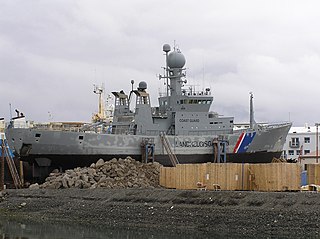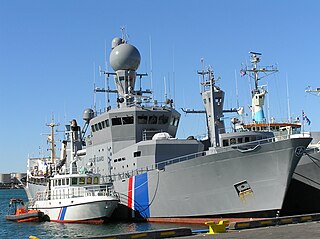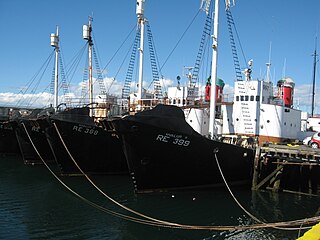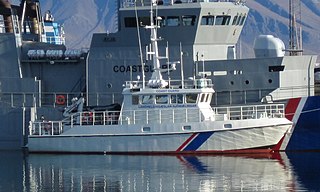
Iceland's defence forces consist of the Icelandic Coast Guard, which patrols Icelandic waters and monitors its airspace, and other services such as the National Commissioner's National Security and Special Forces Units. Iceland maintains no standing army, the only NATO member for which this is the case.
The Cod Wars were a series of 20th-century confrontations between the United Kingdom and Iceland about fishing rights in the North Atlantic. Each of the disputes ended with an Icelandic victory.

The Icelandic Coast Guard is the service responsible for search and rescue, maritime safety and security surveillance, and law enforcement in the seas surrounding Iceland. The Coast Guard maintains the Iceland Air Defence System which conducts ground surveillance of Iceland's air space and operate Keflavik airbase. It is also responsible for hydrographic surveying and nautical charting.

The Norwegian Coast Guard is a maritime military force which is part of the Royal Norwegian Navy. The coast guard's responsibility are for fisheries inspection, customs enforcement, border control, law enforcement, shipping inspection, environmental protection, and search and rescue. It operates throughout Norway's 2,385,178-square-kilometer (920,922 sq mi) exclusive economic zone (EEZ), internal waters and territorial waters. It is headquartered at Sortland Naval Base. In 2013 the Coast Guard had 370 employees, including conscripts, and a budget of 1.0 billion Norwegian krone.

ICGV Týr is an Ægir-class offshore patrol vessel and the former flagship of the Icelandic Coast Guard. The ship was built by Dannebrog Værft in Denmark in 1974–1975 and entered service in 1975. Týr is the second largest ship in the Icelandic Coast Guard and participated in the Third Cod War. The ship conducted patrols, search and rescue, fishery inspections, general law enforcement and counter-terrorism operations in the Icelandic exclusive economic zone and the waters of the surrounding territories, such as Greenland and Jan Mayen. Týr was decommissioned in 2021 and sold in 2022.

ICGV Ægir is a former offshore patrol vessel of the Icelandic Coast Guard. Built by Aalborg Værft, in Denmark, she is the lead ship of the Ægir class and has one sister ship of an improved design, ICGV Týr. The ship entered service in 1968 and participated in the two last Cod Wars against the United Kingdom. Ægir primarily conducts patrols, search and rescue, fishery inspections, general law enforcement and counter-terrorism operations in the Icelandic exclusive economic zone. In 2020, the patrol vessel was taken out of service and sold two years later.

ICGV Óðinn is a decommissioned offshore patrol vessel formerly operated by the Icelandic Coast Guard. She is the oldest ship in the coastguard's fleet, and it is believed that her Burmeister & Wain engines are the only such engines that are still serviceable in the world today. Since her withdrawal from active duty, she has served as a floating exhibit at the Reykjavík Maritime Museum in Reykjavík Harbour. The ship is still maintained, and operative as of June 2022.

The Asheville-class gunboats were a class of small warships built for the United States Navy in response to the Cuban Missile Crisis. The class is named for a city in western North Carolina and the seat of Buncombe County. All Asheville-class gunboats have since been donated to museums, scheduled for scrapping, or transferred to the Greek, Turkish, Colombian and South Korean Navies. The last two Asheville-class gunboats in US service were USS Chehalis and USS Grand Rapids, which were operated by the Naval Surface Warfare Center until they were stricken in 2016.

ICGV Þór (Thor) is an UT 512L type offshore patrol vessel designed by Rolls Royce for the Icelandic Coast Guard, built to replace the aging ICGV Óðinn. The construction of the ship was approved by the Icelandic government on 4 March 2005. Construction of the ship began at the ASMAR Naval Shipyard in Talcahuano, Chile, on 16 October 2007. Construction was delayed by over a year due to the 2010 Chilean earthquake, but damage to the structure of the ship was not as detrimental as had been expected. After repairs, the ICGV Þór was delivered to ICG personnel on 23 September 2011 in Chile. She arrived in Reykjavík on 27 October 2011. Its main tasks are EEZ patrol, fishery inspection and search and rescue support. The ship is named after the Norse god Thor.

The Ægir-class offshore patrol vessel is a class of two offshore patrol vessels serving in the Icelandic Coast Guard (ICG). They participated in the two latter Cod Wars. The vessels conduct patrols, search and rescue, fishery inspections, general law enforcement and counter-terrorism operations in the Icelandic exclusive economic zone and the waters of the surrounding territories, such as Greenland and Jan Mayen.
This is a brief overview of historical warfare and recent developments in Iceland. Iceland has never participated in a full-scale war or invasion and the constitution of Iceland has no mechanism to declare war.

Hvalur 9 RE-399 is an Icelandic whaling ship built in 1952 in Norway. It has been a part of the Icelandic whaling fleet operated and owned by the company Hvalur hf. since 1966.

Thor was a Danish research vessel from 1903 to 1927. She was built by Edwards Brothers at North Shields, England in 1899 as a steam trawler. Thor conducted hydrographical and oceanographical research in the North Atlantic and the Mediterranean and helped locate the spawning grounds of the Icelandic cod. Most importantly, Thor conducted two expeditions to the Mediterranean Sea in 1908-1910 with Johannes Schmidt as cruise leader. The aim of the expeditions, funded by the Carlsberg Foundation, was to locate the spawning grounds of the European eel. Contrary to their expectations the expeditions found that fewer eel larvae (leptocephals) were found the deeper they went into the Mediterranean, but they also grew larger. The logical conclusion was that the spawning grounds were not in the Mediterranean, but in the Atlantic Ocean. In a broader perspective, the greatest result of the two expeditions was the very large contribution to the general understanding of the oceanography and pelagic fauna of the Mediterranean.

ICGV Þór was an offshore patrol vessel of the Icelandic Coast Guard. The third coast guard ship to bear the name, she was the flagship of the fleet and served in all three Cod Wars conflicts between Iceland and the United Kingdom.

Sif, also known as TF-SIF, is an Aerospatiale SA365N Dauphin 2 helicopter used by the Icelandic Coast Guard from 1985 to 2007. It took part in several high profile rescue operations around Iceland during its 22-year career and is credited to have been involved in the rescue of around 250 lives. It is named after Sif, the golden-haired goddess from Norse mythology and is the third Coast Guard aircraft to bear the name. Since 2008, it has been on display at the Icelandic Aviation Museum.

Líf, also known as TF-LÍF, is an Aérospatiale AS-332L1 Super Puma helicopter used by the Icelandic Coast Guard. It is named after Líf, the only woman foretold to survive the events of Ragnarök from Norse mythology, and is the first Coast Guard aircraft to bear the name. It is the longest serving helicopter in the history of the ICG and gained national fame when it rescued 39 sailors in three separate incidents during a six-day period in March 1997.

María Júlía is a former coast guard vessel, operated by Icelandic Coast Guard from 1950 to 1969 as a rescue, research and patrol ship. It served in the first Cod Wars conflict between Iceland and the United Kingdom from 1958 to 1961. It is estimated that the ship's crew rescued about 2,000 people during its service with the Coast Guard.

ICGV Baldur is a surveillance and surveying vessel of the Icelandic Coast Guard. The ship was built by Vélsmiðja Seyðisfjarðar in Iceland in 1991 and entered service the same year. Over its three decade career it has been used for surveying, surveillance, law enforcement, exercises and various other projects along the country's shores. The ship is named after the Norse god Baldur and is the third coast guard vessel to bear the name.
ICGV Ægir was an offshore patrol vessel of the Icelandic Coast Guard built by Burmeister & Wain, in Denmark in 1929. It was named after Ægir, the personification of the sea in Norse mythology. The ship entered service in July 1929 and participated in the first of the Cod Wars against the United Kingdom. Ægir primarily conducted patrols, search and rescue, fishery inspections, research and nautical surveying operations in the Icelandic exclusive economic zone. With the arrival of new Ægir in 1968, the ship was decommissioned and sold for scrap.

Hvalur 8 RE-388 is an Icelandic whaling ship built in 1948 in Norway. It has been a part of the Icelandic whaling fleet operated and owned by the company Hvalur hf. since 1962.
















